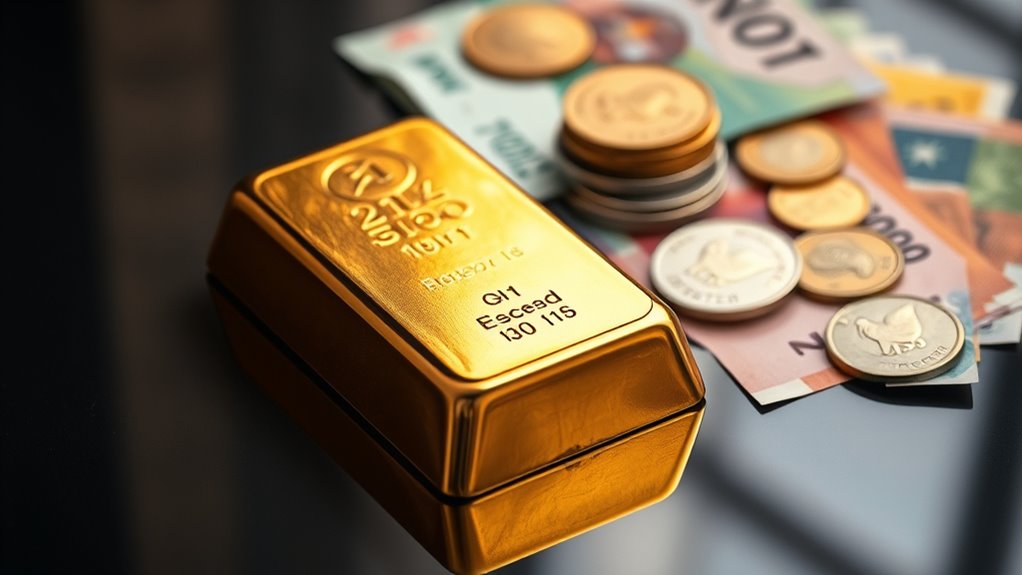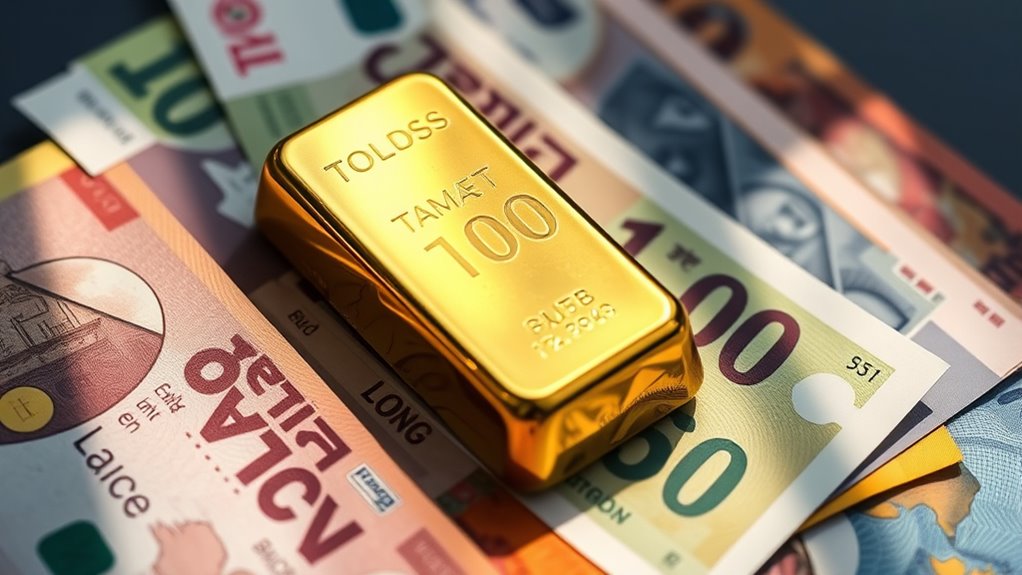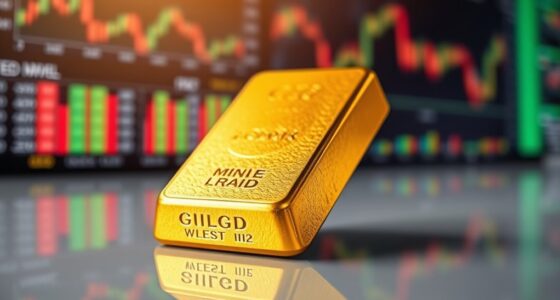You’ll notice that gold and emerging-market currencies often move together, especially during times of economic or political uncertainty. When EM currencies weaken, gold prices tend to rise as investors seek safety and preserve wealth. Many countries consider using gold for trade and reserves, boosting this connection further. Understanding how currency fluctuations impact gold can help you anticipate market shifts. Stick with us to uncover more about this hidden bond and how it affects your investments.
Key Takeaways
- EM currency depreciation often leads to increased gold demand as a safe haven.
- Gold prices tend to move in tandem with fluctuations in emerging market currencies.
- Countries exploring gold for trade settlements reinforce its role as a reserve and hedge asset.
- Political and economic uncertainties in EMs boost gold’s appeal as a financial stability tool.
- The strong link between EM currency health and gold prices influences investment and risk management strategies.

Gold and emerging-market currencies are increasingly intertwined as global financial dynamics shift. You’ll notice that as currencies in emerging markets face volatility, their demand for gold often rises sharply. This pattern isn’t coincidental. When local currencies weaken due to economic or political uncertainty, people turn to gold as a safe haven. Gold’s value tends to hold or even increase while local currencies depreciate, making it a crucial tool for preserving wealth in these regions.
In recent times, the relationship between EM currencies and gold has become more pronounced. As currencies like the Brazilian real, South African rand, or Indian rupee fluctuate, gold prices tend to move in tandem, reflecting this interplay. When EM currencies slide, investors and local buyers increase their physical gold purchases, which pushes prices higher. Conversely, stability or strength in these currencies can temper gold demand, leading to a more subdued price movement. This tight coupling underscores gold’s role as a hedge against currency depreciation.
You should also consider how some emerging economies are exploring new ways to settle international transactions, including the use of gold. Countries like those in BRICS are contemplating alternatives to the U.S. dollar for trade. This shift could elevate gold’s status in reserve holdings and international finance, further reinforcing its link with EM currencies. As these nations diversify their reserves away from the dollar, gold’s role as a global reserve asset becomes more prominent, especially for emerging markets seeking stability amid dollar dominance.
Volatility and economic policy uncertainty in emerging markets boost gold’s appeal as a portfolio diversifier. You’ll see that during times of political turmoil, inflation fears, or external shocks, local demand for gold skyrockets. This demand acts as a buffer, helping households and governments safeguard their wealth from currency devaluation. Gold’s price movements often mirror these currency weaknesses, making it a barometer for economic stability in emerging markets.
In essence, the health of EM currencies directly influences gold prices, with the relationship intensifying during periods of financial stress. As global trade tensions, geopolitical conflicts, and monetary policies evolve, this correlation is likely to deepen. For you, understanding this dynamic means recognizing gold’s crucial role not just as an investment but as a currency hedge that responds to the unique risks faced by emerging markets in today’s interconnected economy. Additionally, the high liquidity of gold allows it to be quickly mobilized during times of crisis, reinforcing its importance as a financial safety net.
Frequently Asked Questions
How Do Geopolitical Events Influence Gold and Emerging-Market Currency Correlations?
Geopolitical events impact gold and emerging-market currencies by increasing uncertainty, which usually drives investors toward gold as a safe haven, causing its price to rise. Meanwhile, currencies in emerging markets tend to weaken due to capital flight and risk aversion. These events can cause a temporary decoupling or stronger correlation depending on how central banks respond, sanctions are enforced, and global monetary policies shift during conflicts.
What Role Do Central Banks Play in This Relationship?
Imagine central banks as skilled tightrope walkers balancing between stability and risk. They play a pivotal role by actively shifting reserves into gold, especially during geopolitical storms. This move acts like a safety net, helping to stabilize their currencies amid turmoil. By diversifying into gold, they shield their economies from external shocks and currency volatility, guiding their nations safely across turbulent financial landscapes.
Are There Specific Emerging Markets Where This Correlation Is Stronger?
You’re asking if certain emerging markets show a stronger correlation between gold and their currencies. Markets like Turkey and India have a particularly tighter link, driven by high inflation, economic uncertainty, and cultural factors. You’ll find that in these countries, gold acts as a hedge against currency devaluation, making the correlation more pronounced. Monitoring these markets can give you insights into how currency fluctuations influence gold demand and prices.
How Can Investors Leverage This Correlation in Their Portfolios?
You can leverage this correlation by adjusting your portfolio to include gold as a hedge against emerging-market currency risks. When EM currencies weaken, gold prices often rise, so holding gold can offset potential losses in EM assets. Additionally, diversifying with gold during economic or geopolitical uncertainty can improve stability. Monitor global trends, central bank policies, and currency movements to time your allocations effectively and maximize risk mitigation.
Does Economic Stability Impact the Gold-Currency Relationship?
Economic stability is like a calm sea, influencing the gold-currency relationship markedly. When stability prevails, gold’s safe-haven appeal diminishes, and currencies become more resilient. Conversely, instability causes gold demand to spike, especially in emerging markets, as investors seek refuge. You’ll notice that stable economies tend to weaken gold’s influence on currencies, while uncertainty makes gold a powerful hedge, impacting currency values more dramatically.
Conclusion
As you navigate the intricate dance between gold and emerging-market currencies, remember they’re like twin flames flickering in a turbulent wind—linked by an unseen, powerful force. Recognize that understanding this hidden correlation can be your compass through financial storms, guiding you toward calmer waters. Embrace the subtle symphony of these assets, for beneath their surface lies a secret rhythm, waiting for you to decode it and harness its silent strength in your investment voyage.




